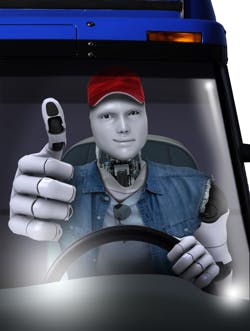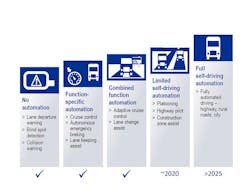If you're waiting for a self-driving, heavy-duty truck – those in the field prefer the term 'autonomous truck' – it's only ten years away, according to a recently-published report by Roland Berger Strategy Consultants GmbH.
"Limited self-driving trucks are not expected to reach series-production readiness before 2025. The technology is almost there, but legal hurdles have to be overcome," Sebastian Gundermann, partner in the consultancy's Automotive Competence Center, said in a prepared statement.
The report "On The Road Toward The Autonomous Truck: Opportunities For OEMs and Suppliers" notes that new legal frameworks are required before autonomous trucks can hit the road. In all U.S. states, autonomous trucks are prohibited on public roads although self-driving cars are permitted with conditions in three states: California, Florida and Michigan. One of the first and most obvious legal question is: who is responsible if the truck is in a crash? If the truck disobeys a traffic regulation, who gets the ticket? How are insurance premiums calculated? If the truck fails a roadside inspection, who accepts the citation?
Legal issues aside, the report notes that technical challenges lie ahead mainly in the area of sensors and the software that connects to them. "From a technical perspective, the main need for innovation is on the software side. Systems must orchestrate highly-complex driving behaviors and have a fail-operational architecture [systems that still work when control systems fail] that protects against technical failure and covers system malfunction," the report stated.
This will take a huge amount of data crunching. "To process around 300 GB of data per hour, to integrate the truck with the cloud, and to implement stricter security mechanisms, the in-vehicle network will switch to IP-based communication. The key requirements of these architectures are safety and security. Systems must have a fail-operational architecture that can still function in the event of minor errors and have a safe mode in case of serious technical failure. Further, systems must be secure in order to prevent external access to the system."
- In the first stage, trucks are not automated and assistance systems provide truck drivers with warning information in clearly-defined scenarios such as lane departure.
- In the next stage, vehicle systems actively assist the driver in clearly-defined driving scenarios such as in the event of lane departure and produce single function-responses such as steering changes.
- In the combined function automation stage, vehicles take over driver tasks but not driver responsibility. The driver must still be attentive and able to retake control when necessary.
- Under limited self-driving automation, the driver can engage in other activities while the truck, for example, chauffeurs the driver along the highway or through traffic jams.
- The final stage is full self-driving automation where the driver is practically no longer required.
And what of truck drivers? The report noted: "The second-largest cost factor, the driver, will still need to be in the cabin – at least for the next decade. However, in highly-automated trucks, drivers will now have time to engage in productive work like planning the next delivery or enjoying some leisure time."
About the Author

Larry Kahaner
Larry Kahaner is an author, journalist, and former FleetOwner contributor.

